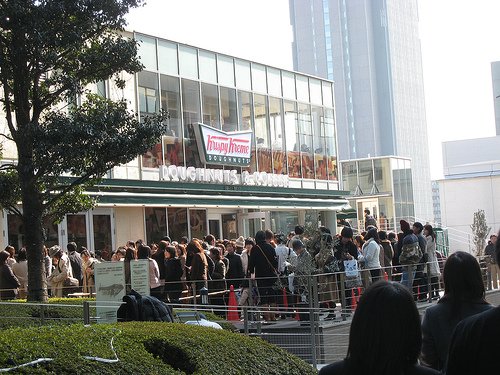Japan is nothing if not the land of contradictions. On the one hand, society has been organized in a vertical structure that puts barriers of politeness in place, resulting in top-down relationships that shuffle more respect to higher-level individuals (senpai, sensei, etc.) while requiring them to play their part by providing guidance and leadership to those younger than them, picking up the tab at restaurants, and so on. On the other hand, the Japanese have managed to achieve what Marx and Lenin could not, creating a society where 90% or more of the people consider themselves to be part of the same equal social group, in this case Japan’s sprawling middle class. It’s not exactly clear to my gaijin mind why someone driving a BMW 750i would go out of their way to consider themselves in the same group as those of us of lesser means, but for the most part Japanese of all income levels seem to strongly identify with the middle class. While everyone feeling like they’re all part of one big happy in-group is certainly a good thing overall, there are some downsides, too. For example, one of the reasons there are so many “personal finance” (loan shark) companies like ACOM, Promise and Lake, which loan money at 20-30% to people who should know better, is that their customers seem to have a desire to “keep up with the Yamadas” and buy things they don’t need to reassure themselves that they’re not falling outside the main economic group. The cover of the current Japanese Newsweek has a feature article dealing with this strange phenomenon, entitled “it’s okay to live a class-differentiated society, Japan!”

One observation I’ve made before about Japan is that it generally seems to follow a decade or so behind the U.S., with many aspects of society appearing in Japan about ten years after making their debut in the States. Everything from the revolution in e-commerce to laws curbing smoking in public places seems to get started in the U.S. then make its way over to Japan after a several-year delay. Quite a few businesses that are successful in Japan merely watched for new trends to emerge in the U.S. — like home pizza delivery or NetFlix — and brought the ideas to market locally before the original company could set up shop here. Perhaps the next trend in ideas being imported from the U.S. will be food-related. A couple of weeks ago, I went to Tokyo and happened to pass the new Krispy Kreme doughnut shop that I’d heard had been built in Shinjuku’s south side. I didn’t think it would be that popular, though, and I was bowled over by the massive press of people waiting two hours or more for their turn to buy. The sight of slender, stylish Tokyoites carrying three dozen doughnuts back the office was also new to me.
The Japanese have some interesting customs when it comes to driving. When waiting at an intersection, it’s considered polite to turn your headlights down (put them in “park” mode) so that you don’t blind the person in front of you. When someone lets you in front of them, you flash your emergency lights at them twice to say “thank you.” And around our city, young men with nothing to do at night will drive around the train station looking for girls in cars, and when they see them they flash their high beams in a gesture that seems to mean “let’s go get some coffee together” (an act which is called nampa, apologies to people in Nampa, Idaho). Another interesting car-related thing they do in Japan is the “Beginner’s Mark,” a green-and-yellow sign that newly licensed drivers must put on their cars for the first year that lets other cars know that the driver may not have as much experience as a full-fledged driver, and presumably give them a wider berth on the road. Similar to this is a Senior Citizen’s Mark, an orange-and-yellow sign that older drivers can put on their car (with either magnetic or suction-cup attachment), a way to let other drivers know they should give you the respect you deserve and get out of your way. I like to imagine the confusion in the minds of Japanese people when they wonder why these only-found-in-Japan signs are being displayed on cars in the U.S. — which is why we sell both on the site, of course.
J-list carries virtually every PC dating-sim game available in English, and we’re always happy to see customers discover the interesting and dramatic world of Japan’s “H” gaming culture. We also license and publish “doujin” CG collections, which are created by artists for sale at the legendary Comic Market doujinshi convention held twice a year at Tokyo Big Sight. We’re happy to report that two of our popular collections are now available as Internet Download Editions, so fans who missed out on these great collections can get them again. First there’s Dream World II, a breathtakingly beautiful collection of several separate releases by Japanese artist Kobayashi Yuji that parodies the characters of Evangelion and more. Then enjoy all three of our previous Creamy Angel CD-ROM releases available as an Internet Download, a staggering gigabyte of top “H” artwork by Japanese illustrator Mashitaka, including his speciality of Ah! My Goddess futanari (um, wow).
Remember that the summer anime conventions are not that far off, and what better way to wow ’em at the shows this year than wearing your very own authentic Japanese high school uniform. J-List has an exclusive arrangement with the famous Matsukameya of Nagoya, a company that brings real high school uniforms to fans all around the world. Here’s how to order: check the site for the type of uniform you’d like (we’ve got several styles of uniforms for girls, and a standard gakuran school uniform for guys, too), and find which size is closest to your body measurements on the chart. Then submit your order, and we’ll get your new high school uniform off to you as soon as its delivered to us by the company.














